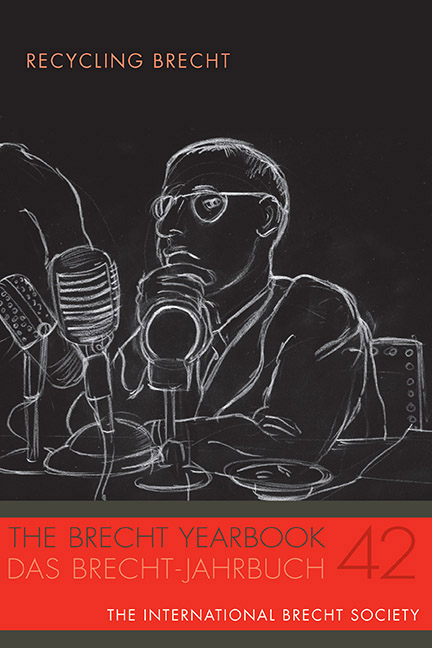East Meets East: Recycling Brecht in India
Published online by Cambridge University Press: 09 April 2021
Summary
In this paper, I argue that between the late 1960s and early 1970s, Brechtian theater in India should be understood as the name for a form of political theater that instilled the ideal and the practice of political aesthetics into the fabric of Indian theater. I propose that this politicization of Indian theater was the result of the creation of a new “theatrical idiom” of Gestic Realism through the implementation of Brechtian aesthetics. The idiom of Brecht's Gestic Realism goes beyond a photographic reproduction of an immediate reality and it encourages the activity of unmasking society's hidden causal complexities. In contrast to realism and naturalism, where ideology is hidden or covert, Brecht's Gestic Realism makes ideology visible by “revealing the causal complex of society/unmasking the ruling viewpoints as the viewpoints of the rulers/writing from the standpoint of the class that has in readiness the broadest solutions for the most urgent difficulties besetting human society/emphasizing the factory of development/concretely and making it possible to abstract.” In the Indian context, this idiom of Gestic Realism was significant on two counts. First, it differed from the prevalent conventions of political theater in India, which were either Socialist Realist (content-based) or naturalistic (mimetic). Second, the “unstageability” of certain aspects of Gestic Realism provided both a resistance to the bourgeois institution of theater, which according to Brecht “can stage anything: it ‘theatricalizes’ it all,” and a sense of recognition to the Indian audience. If this resistance was due to the aesthetics of Gestic Realism, which got produced in the psyche of the activated audience rather than onstage, then the recognition was primarily because of a connection between Gestic Realism and the “poetic realism” of traditional Indian theater. I analyze one such instance of Brechtian aesthetics—that is, of Gestus, a Brechtian device that establishes a “visible connection” between “the actor's body” and its relationship with “social contexts.” Besides highlighting the formation of a new theatrical idiom through this analysis of Gestus, I argue that the device of Gestus is dependent on the social and political contexts of the target audience, which means that the Indian version of Brechtian theater will continue to be different from its European counterpart. Importantly, the Indian production requires a new Gestus that remains comprehensible to the local audience.
- Type
- Chapter
- Information
- The Brecht Yearbook / Das Brecht-Jahrbuch 42Recycling Brecht, pp. 137 - 152Publisher: Boydell & BrewerPrint publication year: 2018



